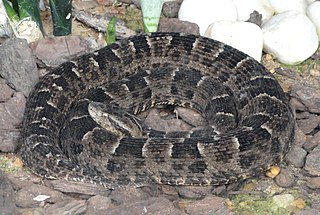
Bothrops atrox — also known as the common lancehead, fer-de-lance, barba amarilla and mapepire balsain — is a highly venomous pit viper species found in the tropical lowlands of northern South America east of the Andes, as well as the Caribbean island of Trinidad. No subspecies are currently recognized.

Bothrops is a genus of highly venomous pit vipers endemic to the Neotropics. The generic name, Bothrops, is derived from the Greek words βόθρος, bothros, meaning 'pit', and ὄψ, ops, meaning 'eye' or 'face', together an allusion to the heat-sensitive loreal pit organs. Members of this genus are responsible for more human deaths in the Americas than any other group of venomous snakes. Currently, 48 species are recognized.

Lachesis muta, also known as the Southern American bushmaster or Atlantic bushmaster, is a venomous pit viper species found in South America, as well as the island of Trinidad in the Caribbean. Two subspecies are currently recognized, including the nominate subspecies described here.

Bothrops alternatus is a highly venomous pit viper species found in South America. Within its range, it is an important cause of snakebite. The specific name, alternatus, which is Latin for "alternating", is apparently a reference to the staggered markings along the body. No subspecies are currently recognized.

The terciopelo is a species of pit vipers, found in Central to South Americas. At low to moderate elevations, its habitat ranges from northeastern Mexico to Colombian and Ecuadorian Andes, as well as Venezuela. With a mass of up to 6 kilograms (13 lb), and a maximal length of 2.5 metres (8.2 ft), the terciopelo is among the largest vipers. It is light to dark brown in color, often with yellowish, zig-zag patterning on either side of its body. Dubbed "the ultimate pit-viper" for its defensiveness, large size, fangs and potent venom yield, it has a fearsome reputation, responsible for the most envenomated snakebites within its range, largely due to its proximity to humans, livestock and pets. Nonetheless, like all venomous snakes, the terciopelo actively avoids contact with humans and larger animals, with bites generally only occurring when the snake is cornered, pursued, or threatened. No subspecies are currently recognized.

Bothrops ammodytoides is a venomous pit viper species endemic to Argentina. No subspecies are currently recognized.

Bothrops jararaca—known as the jararaca or yarara—is a highly venomous pit viper species endemic to South America in southern Brazil, Paraguay, and northern Argentina. The specific name, jararaca, is derived from the Tupi words yarará and ca, which mean 'large snake'. Within its geographic range, it is often abundant and is an important cause of snakebite. No subspecies are currently recognized.

Bothrops insularis, commonly known as the golden lancehead, is a highly venomous pit viper species found exclusively on the Ilha da Queimada Grande, off the coast of São Paulo state, in Brazil. The species is named for the light yellowish-brown color of its underside and for its head shape that is characteristic of the genus Bothrops. No subspecies of Bothrops insularis are currently recognized. It is one of the most venomous snakes in Latin America.

Bothrops neuwiedi is a highly venomous pit viper species endemic to South America. This relatively small snake has a wide range and is a major source of snakebite in Argentina. It was named after German naturalist Prince Maximilian of Wied-Neuwied (1782-1867), who made important collections in Brazil (1815-1817). Seven subspecies are currently recognized, including the nominate subspecies described here.

Bothrops bilineatus, also known as the two-striped forest-pitviper, parrotsnake, Amazonian palm viper, or green jararaca, is a highly venomous pit viper species found in the Amazon region of South America. Two subspecies are currently recognized, including the nominate subspecies described here. A pale green arboreal species that may reach 1 m (3.3 ft) in length, it is an important cause of snakebite throughout the entire Amazon region.

Bothrops jararacussu, commonly known in English as the jararacussu, is a highly venomous pit viper species endemic to South America. It is one of the most dreaded snakes in South America and can grow up to 2.2 metres (7.2 ft).

Bothrops moojeni, commonly known in English as the Brazilian lancehead, is a species of venomous snake in the family Viperidae. It is a pit viper endemic to South America.
Yarara or Yarará is the common name of the venomous pit viper species Bothrops jararaca endemic to southern Brazil, Paraguay, and northern Argentina. Also known as Yarará perezosa (Argentina), jararaca (Brazil)

Bothrops diporus, also known in Portuguese as Bocuda, Cabeça-de-Capanga, Jararaca-do-Chaco, Jararaca-do-Rabo-Branco, Jararaca-Pintada, Jararaca-Pintada-Argentina and Jararaca-Pintada-do-Sul, is a species of viper from the forests of Argentina, Brazil, Paraguay and Bolivia. As with all vipers, it is venomous.
Bothrops germanoi, also known as Moela's lancehead or jararaca-damoela is a species of pit viper from São Paulo, Brazil. It is named after Mr Valdir J. Germano, who is regarded as one of the most renowned Brazilian experts in snake identification.
Bothrops jabrensis, also known as Jabre's Lancehead or jararaca-do-jabre in Portuguese, is a species of Brazilian pit viper from the state of Paraíba. It is named after the area in which it was first discovered, Pico do Jabre, in 2022.

Bothrops muriciensis, also known as Jararaca, Jararaca-de-Alagoas, Jararacuçu in Portuguese, is an endangered species of pit viper which is named after the forest it is known to inhabit, Mata de Murici, in Alagoas in the north east of Brazil. As with all vipers, B. muriciensis is venomous.
Bothrops otavioi, also known as Jararaca-de-Vitória in Portuguese, is an endangered species of pit viper from Vitória Island, São Paulo, Brazil. It is considered on of the top 30 most endangered viper species, possibly critically. The species is named after Otavio A. V. Marques, a prominent herpetologist at the Instituto Butantan. Similarly, the English name 'Vitória's Lancehead' has been suggested for common use.














